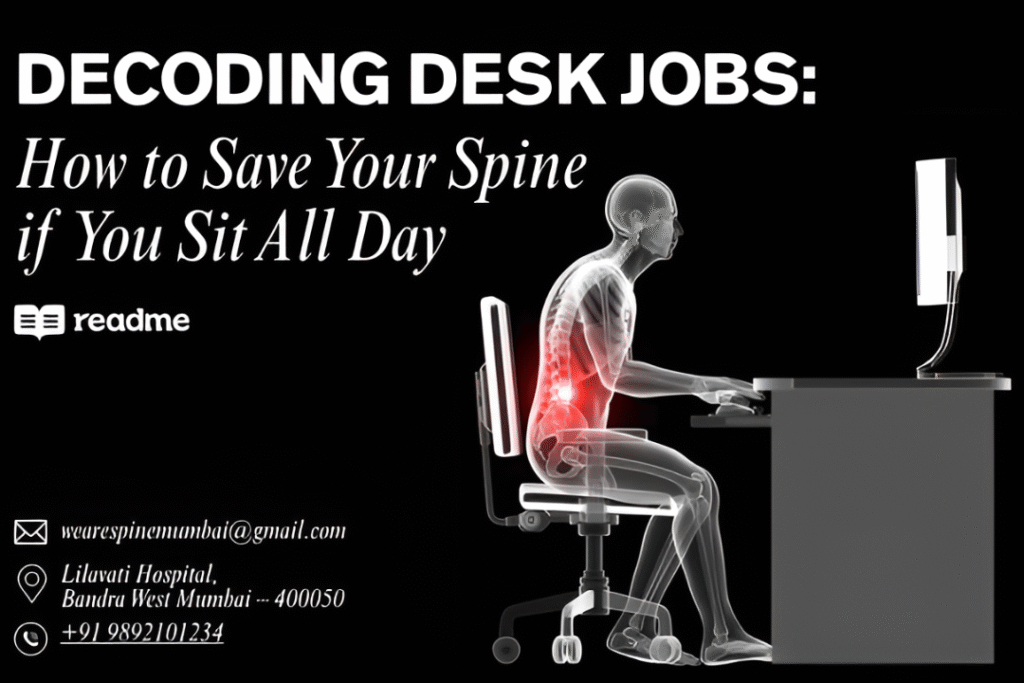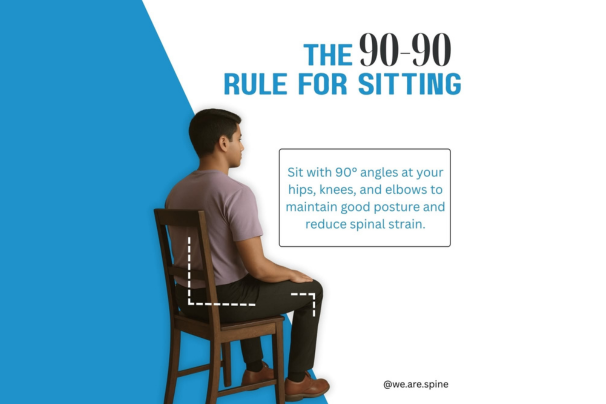
The Modern Work Culture and Your Spine
From IT professionals and designers to teachers and telecallers, millions of Indians today spend the majority of their workday seated at a desk. While this might sound less physically demanding than field jobs, sitting for prolonged hours is silently harming your spine.
At We Are Spine, our mission is to raise awareness about spinal health through accurate medical knowledge, and promote prevention as the first step toward a pain-free life. This blog takes a factual deep-dive into how desk jobs contribute to spinal issues and what you can do to safeguard your back—starting today.
How Sitting All Day Impacts Your Spine
When you sit, particularly in a slouched or static posture, several things happen:
- Your spine’s natural S-curve flattens, stressing the lower back.
- The intervertebral discs—the cushions between your spine bones—experience increased pressure.
- Blood flow to the spine and surrounding muscles reduces, leading to fatigue and stiffness.
Studies show that lumbar disc pressure increases by up to 40% while sitting compared to standing. (Source: Wilke et al., 1999, Spine journal)
2. Common Spine Issues Among Desk Workers
Prolonged sitting, poor posture, and ergonomically unfit workspaces have led to a noticeable rise in spinal problems among desk job professionals. Spine care clinics, including WeAreSpine, frequently encounter patients experiencing a range of musculoskeletal issues related to sedentary work environments. Some of the most common conditions include:
- Lumbar Spondylosis: Degeneration of the lower spine often linked to chronic slouching or poor lumbar support.
- Cervical Disc Bulge: Caused by sustained forward head posture while using screens.
- Sciatica: Nerve compression due to prolonged sitting and disc pressure.
- Text Neck Syndrome: Neck strain resulting from frequent device use with poor head positioning.
- Myofascial Pain Syndrome: Localized muscle pain and trigger points due to static posture and lack of movement.
These conditions highlight the urgent need for spine-friendly workplace habits, early diagnosis, and preventive care strategies—areas actively addressed by spine health professionals and institutions like WeAreSpine.
The body and mind are interconnected. Chronic stress at the workplace leads to muscle tension, poor posture, and elevated pain perception. People under psychological stress tend to unknowingly tense their shoulder and back muscles, exacerbating pain conditions.
The Science-Backed Dangers of Prolonged Sitting
A Sedentary Epidemic
According to a 2020 WHO report, physical inactivity is among the top 10 leading causes of death globally. Desk jobs are a major contributor to a sedentary lifestyle, with repercussions far beyond spinal health:
- Reduced metabolic rate
- Higher risk of diabetes and heart disease
- Obesity-related spine load
- Muscle deconditioning, particularly core muscles that support the spine
Office Ergonomics: The Missing Puzzle
Poor office ergonomics is a silent hazard. Most workstations in India—especially in small offices and homes—are not designed keeping spinal health in mind. Factors such as:
- Non-adjustable chairs
- Screens placed too low
- Inadequate lumbar support
- Absence of footrests
All contribute to poor sitting posture and cumulative spine stress.
Red Flags: When to Take Action
Here are signs that your desk job might be harming your spine:
- Frequent neck or back stiffness
- Radiating pain down the arms or legs
- Numbness or tingling in fingers/toes
- Pain that worsens by the end of the workday
- Poor sleep due to back discomfort
Early intervention is key. At We Are Spine, we recommend seeing a spine specialist if you experience any of these symptoms consistently.
WeAreSpine’s Expert Tips: How to Save Your Spine if You Sit All Day
1. Master the Art of Ergonomic Sitting
Set up your workstation to support—not sabotage—your spine health.
- Chair: Use one with lumbar support, adjustable height, and armrests.
- Feet: Flat on the ground or on a footrest. Avoid crossing legs.
- Screen: At eye level, about an arm’s length away.
- Keyboard & Mouse: Close enough so your elbows are at a 90° angle.
Tip: The 90-90-90 rule is golden—hips, knees, and elbows should be at 90° angles when seated.

2. Incorporate Micro-Movements
Sitting is not bad—sitting still for hours is. Change your position every 20–30 minutes.
- Stand while taking calls
- Do shoulder rolls and neck tilts at your desk
- Get up to fetch water or walk to a colleague’s desk
At We Are Spine, we call this “Movement Nutrition” — short, regular movements that nourish your spine.
3. Use the 20-20-20 Rule
For screen-heavy jobs, every 20 minutes:
- Look at something 20 feet away
- For at least 20 seconds
This not only protects your eyes but also reminds you to shift posture, relax your neck, and reduce cognitive load.
4. Stretch Like Your Spine Depends on It—Because It Does
Incorporate the following desk-friendly stretches:
- Seated Spinal Twist
- Shoulder Shrugs
- Neck Side Tilts
- Seated Forward Bend
- Hamstring Stretch (standing)
You can find guided videos for these stretches on We Are Spine’s YouTube Channel, crafted by our physiotherapy experts.
5. Strengthen Your Core
Your core muscles are the natural corset for your spine. Weak core = unsupported spine.
Effective, no-equipment exercises include:
- Bird-Dog
- Glute Bridge
- Plank (even 30 seconds helps!)
- Dead Bug
Our spine specialists and rehab therapists often recommend these as part of a desk-worker spine care routine.
Workplace Wellness: How Employers Can Help
1. Promote Active Work Culture
- Walking meetings
- Standing desks
- Scheduled stretch breaks
2. Ergonomic Assessments
Employers should consider periodic ergonomic audits and offer adjustable workstations.
3. Employee Education
Wellness workshops on spinal health, stress management, and posture awareness are powerful tools to reduce absenteeism and enhance productivity.
At We Are Spine, we collaborate with workplaces to conduct spine health seminars and ergonomic awareness drives. Reach out if you’d like to host one at your company.
Tech Tools That Support Your Spine
Today, technology can assist you in maintaining good spine health at work:
- Posture Reminder Apps (e.g., PostureMinder, Ergonomic Assistant)
- Fitness Bands/Smartwatches with move reminders
- Sit-Stand Desks that can be adjusted every hour
- Ergonomic Mouse/Keyboard that reduce strain on shoulders and wrists
Home Office? Don’t Compromise
The work-from-home culture has led many to work from couches and beds, worsening posture.
If you’re working remotely:
- Avoid working while lying down.
- Invest in a good chair and table—even if compact.
Use laptop stands and external keyboards for better screen positioning.
Desk Jobs and Spinal Surgery: When Is It Needed?
While most desk-related spine issues can be managed with lifestyle correction and physiotherapy, in some cases:
- Chronic disc herniation
- Spinal canal stenosis
- Nerve root compression
…may require surgical intervention.
At We Are Spine, we follow a conservative treatment-first approach. Surgery is only considered when non-invasive methods fail and quality of life is compromised.
Our team of surgeons use minimally invasive techniques whenever possible, ensuring faster recovery and return to work.
Patient Trends from Desk-Related Spine Complaints
Spine care centers across urban India, including WeAreSpine, report a growing number of young professionals seeking help for posture-induced back and neck pain. Many of these individuals work long hours at computers and experience relief after ergonomic corrections, physiotherapy, and core strengthening exercises.
While individual outcomes vary, these cases underline a larger public health insight: early awareness, spine evaluations, and workplace corrections can significantly reduce the risk of chronic spinal conditions.
Final Thoughts: Sitting Smarter Is the New Working Harder
Desk jobs aren’t going away, but their damage to our spines can be. With simple changes in how we sit, move, and work, we can protect our spines for life.
At We Are Spine, we believe that spinal health is foundational to overall well-being. Don’t wait for pain to start before you act—prevention is your strongest ally.
Quick Checklist: Save Your Spine at Work
Ergonomic Chair with Lumbar Support
Feet Flat on Floor or Footrest
Screen at Eye Level
Move Every 30 Minutes
Daily Core Exercises
Regular Spine Check-Ups
Need Help?
If you’re facing persistent back pain or want to assess your spinal health, consult our spine specialists at wearespine.in. We’re here to guide you toward a pain-free, productive work life.